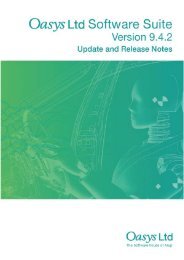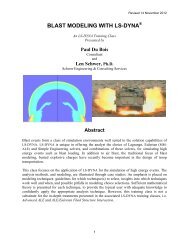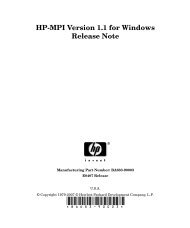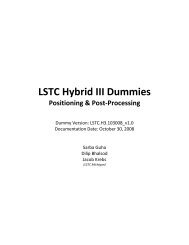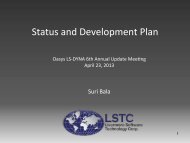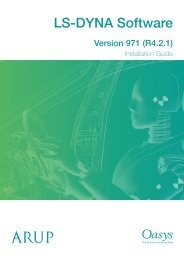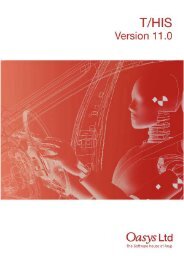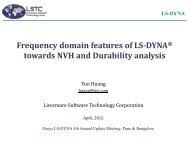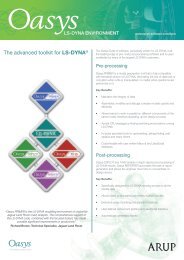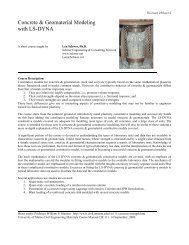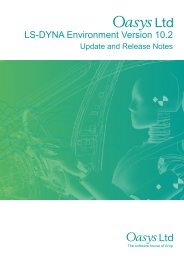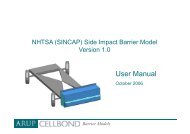Oasys LS-DYNA Environment 8.1 VOLUME 3 ... - Oasys Software
Oasys LS-DYNA Environment 8.1 VOLUME 3 ... - Oasys Software
Oasys LS-DYNA Environment 8.1 VOLUME 3 ... - Oasys Software
Create successful ePaper yourself
Turn your PDF publications into a flip-book with our unique Google optimized e-Paper software.
<strong>Oasys</strong> <strong>LS</strong>-<strong>DYNA</strong> <strong>Environment</strong>: User Guide (Version <strong>8.1</strong>)<br />
ERODE (with DTMIN on *CONTROL_TERMINATION) Elements whose timesteps fall<br />
below SCFT*DTMIN*DTSTART (where DTSTART is the initial timestep) will<br />
be deleted provided that ERODE is set to 1. The disadvantage of this is that the<br />
eroding contact types must be used if solid elements are present, with consequent<br />
increase in memory and CPU requirements. Also the holes left by the deleted<br />
elements can cause contact problems. If DTMIN is non-zero but ERODE is<br />
zero, the run will simply terminate if the timestep falls below<br />
DTMIN*DTSTART.<br />
Note that none of the above options apply to Spring elements. For any Spring elements which<br />
may control the timestep, it is recommended that lumped masses be added to their nodes. In<br />
previous versions of <strong>LS</strong>-<strong>DYNA</strong> it was possible to force <strong>LS</strong>-<strong>DYNA</strong> to ignore spring elements<br />
when calculating the timestep. This option was considered dangerous and has been discontinued.<br />
Optimising the Timestep for Impact Models<br />
Simply enter the required timestep (with a negative sign) as DT2MS on<br />
*CONTROL_TERMINATION. <strong>LS</strong>-<strong>DYNA</strong> will add mass as required to bring the timestep up<br />
to SCFT*DT2MS (N.B. SCFT is usually 0.9; it is advisable to allow for this when selecting a<br />
value of DT2MS). Mass is added only to those elements whose timestep would otherwise have<br />
been less than the specified value. The amount of mass added can be checked in the LOG and<br />
OTF files. Clearly the more mass added, the less accurate the calculation; it is up to the analyst<br />
to decide how much added mass is allowable. To reduce the added mass, reduce the specified<br />
timestep.<br />
Subcycling<br />
Most models contain elements of a range of sizes, and generally the timestep for the whole model<br />
is controlled by the smallest element. Thus CPU time is wasted in recalculating strains and<br />
stresses in the larger elements more often than is required for stability. Subcycling overcomes<br />
this by dividing the elements into groups by timestep, and by using a different timestep for each<br />
group. If the smallest timestep in the model is DT, the timesteps for the groups are DT, 2DT,<br />
4DT, 8DT, 16DT and 32DT. (Further explanation is given in the Theory Manual, Section 21.2).<br />
Subcycling offers a most significant reduction in CPU requirement when there are relatively few<br />
small elements, and the bulk of the elements have a stable timestep at least twice that of the<br />
smallest element: for example, if one small region of a model is meshed much more finely than<br />
the remainder. In a typical crash model, the mesh size is well planned and a large proportion of<br />
the elements have a timestep within a factor of two of the minimum timestep. In these cases,<br />
subcycling is unlikely to reduce CPU cost significantly and may even increase it, especially on<br />
vector machines. To activate subcycling in a model, include *CONTROL_SUBCYCLE in the<br />
input file. No further input is required.<br />
Page 12.3



